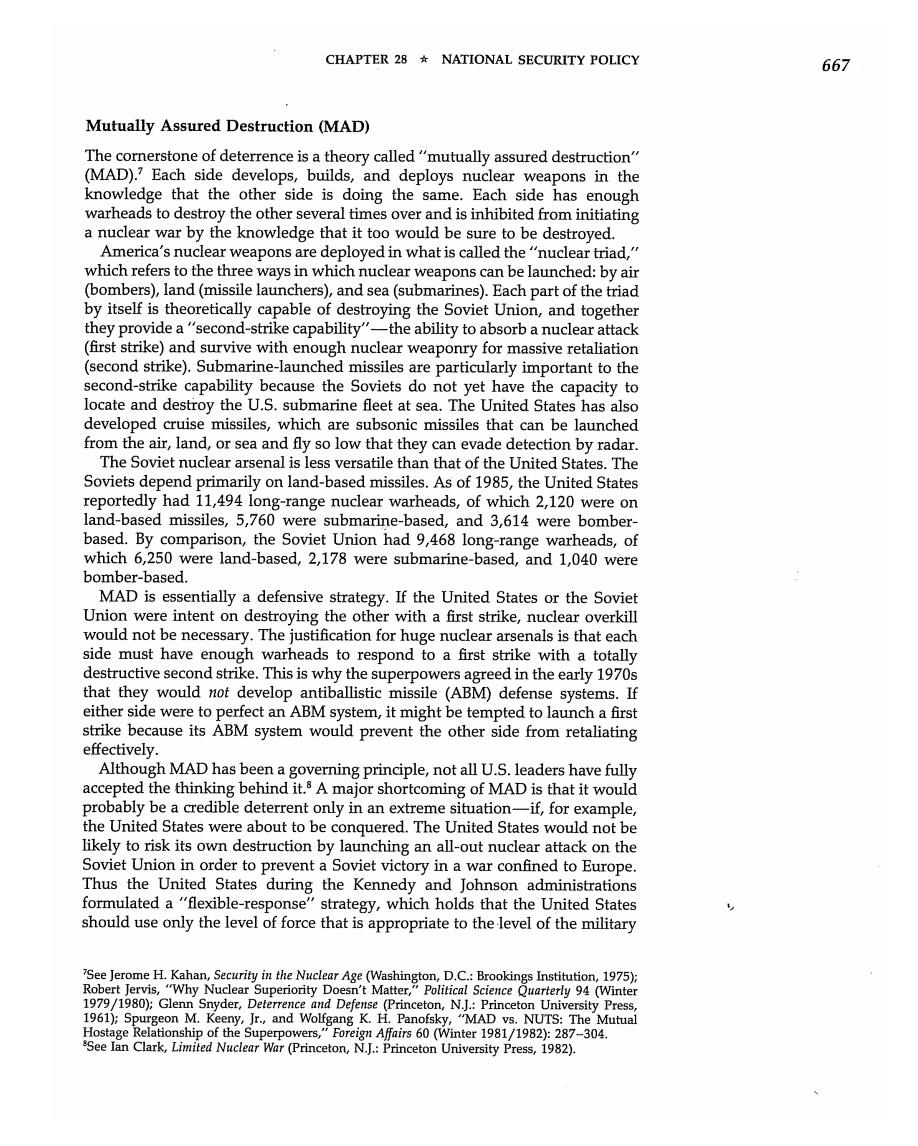正在加载图片...

CHAPTER 28*NATIONAL SECURITY POLICY 667 Mutually Assured Destruction (MAD) The cornerstone of deterrence is a theory called"mutually assured destruction" (MAD).?Each side develops,builds,and deploys nuclear weapons in the knowledge that the other side is doing the same.Each side has enough warheads to destroy the other several times over and is inhibited from initiating a nuclear war by the knowledge that it too would be sure to be destroyed. America's nuclear weapons are deployed in what is called the"nuclear triad," which refers to the three ways in which nuclear weapons can be launched:by air (bombers),land(missile launchers),and sea(submarines).Each part of the triad by itself is theoretically capable of destroying the Soviet Union,and together they provide a"second-strike capability"-the ability to absorb a nuclear attack (first strike)and survive with enough nuclear weaponry for massive retaliation (second strike).Submarine-launched missiles are particularly important to the second-strike capability because the Soviets do not yet have the capacity to locate and destroy the U.S.submarine fleet at sea.The United States has also developed cruise missiles,which are subsonic missiles that can be launched from the air,land,or sea and fly so low that they can evade detection by radar. The Soviet nuclear arsenal is less versatile than that of the United States.The Soviets depend primarily on land-based missiles.As of 1985,the United States reportedly had 11,494 long-range nuclear warheads,of which 2,120 were on land-based missiles,5,760 were submarine-based,and 3,614 were bomber- based.By comparison,the Soviet Union had 9,468 long-range warheads,of which 6,250 were land-based,2,178 were submarine-based,and 1,040 were bomber-based. MAD is essentially a defensive strategy.If the United States or the Soviet Union were intent on destroying the other with a first strike,nuclear overkill would not be necessary.The justification for huge nuclear arsenals is that each side must have enough warheads to respond to a first strike with a totally destructive second strike.This is why the superpowers agreed in the early 1970s that they would not develop antiballistic missile(ABM)defense systems.If either side were to perfect an ABM system,it might be tempted to launch a first strike because its ABM system would prevent the other side from retaliating effectively. Although MAD has been a governing principle,not all U.S.leaders have fully accepted the thinking behind it.s A major shortcoming of MAD is that it would probably be a credible deterrent only in an extreme situation-if,for example the United States were about to be conquered.The United States would not be likely to risk its own destruction by launching an all-out nuclear attack on the Soviet Union in order to prevent a Soviet victory in a war confined to Europe. Thus the United States during the Kennedy and Johnson administrations formulated a"flexible-response"strategy,which holds that the United States should use only the level of force that is appropriate to the level of the military 7See Jerome H.Kahan,Security in the Nuclear Age(Washington,D.C.:Brookings Institution,1975); Robert Jervis,"Why Nuclear Superiority Doesn't Matter,"Political Science Quarterly 94(Winter 1979/1980);Glenn Snyder,Deterrence and Defense (Princeton,N.J.:Princeton University Press, 1961);Spurgeon M.Keeny,Jr.,and Wolfgang K.H.Panofsky,"MAD vs.NUTS:The Mutual Hostage Relationship of the Superpowers,"Foreign Affairs 60(Winter 1981/1982):287-304. See Ian Clark,Limited Nuclear War(Princeton,N.J.:Princeton University Press,1982)